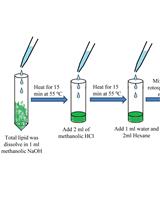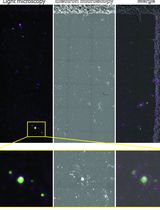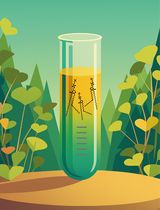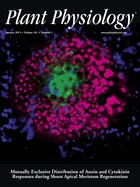- Submit a Protocol
- Receive Our Alerts
- Log in
- /
- Sign up
- My Bio Page
- Edit My Profile
- Change Password
- Log Out
- EN
- EN - English
- CN - 中文
- Protocols
- Articles and Issues
- For Authors
- About
- Become a Reviewer
- EN - English
- CN - 中文
- Home
- Protocols
- Articles and Issues
- For Authors
- About
- Become a Reviewer
Analysis of Flower Cuticular Waxes and Cutin Monomers
Published: Vol 3, Iss 18, Sep 20, 2013 DOI: 10.21769/BioProtoc.899 Views: 10573
Reviewed by: Tie Liu

Protocol Collections
Comprehensive collections of detailed, peer-reviewed protocols focusing on specific topics
Related protocols

GC-MS-Based Analysis of Methanol: Chloroform-extracted Fatty Acids from Plant Tissues
Manish Kumar Patel [...] Jitendra Kumar Thakur
Sep 20, 2018 15406 Views

Sorghum bicolor Extracellular Vesicle Isolation, Labeling, and Correlative Light and Electron Microscopy
Deji Adekanye [...] Jeffrey L. Caplan
Oct 5, 2024 2082 Views

PhosphoLIMBO: An Easy and Efficient Protocol to Separate and Analyze Phospholipids by HPTLC From Plant Material
Louise Fougère [...] Yohann Boutté
Sep 5, 2025 1305 Views
Abstract
Here we describe procedures for the flower cuticular waxes extraction, modification and subsequent qualitative and quantitative analysis by gas-chromotography-mass spectrometry (GC-MS) and gas-chromotography with flame ionization detector (GC-FID), accordingly. To characterize flower cutin monomers two experimental setup are described: (i) analysis of enzymatically isolated cuticles in order to determine the relative proportions of cutin monomers; (ii) analysis of freeze-dried material for quantitative estimation of the cutin content. This report is an adaptation of the earlier published protocols developed for the chemical analysis of the cuticles in vegetative organs (Leide et al., 2007).
Keywords: Cuticular waxesMaterials and Reagents
- Chloroform (Carl Roth, catalog number: 7331.2 )
- Heptatriacontane (Fluka, catalog number: 51848 )
- Dotriacontane (Fluka, catalog number: 44253 )
- N,O-bis-trimethylsilyl-trifluoroacetamide (BSTFA) (Macherey-Nagel, catalog number: 701220.201 )
- Pyridine (Merck, catalog number: 1074630500 )
- 1.25 M methanol-HCl (Fluka, catalog number: 17935 )
- Sodium chloride-saturated aqueous solution (Applichem, catalog number: A2824 )
- Anhydrous sodium sulfate salt (Applichem, catalog number: A1048 )
- Pectinase (Trenolin Super D) (Erbsloh, catalog number: 20312 )
- Cellulase (Cellulast) (Novo Nordisk AIS, catalog number: CA451088 )
- Citric acid monohydrate (Sigma-Aldrich, catalog number: C1909 )
- Liquid nitrogen
- 20 mM citrate buffer, pH 3.0 supplemented with 1 mM sodium azide (see Recipes)
Equipment
- Freeze-drier
- Nitrogen cylinder and blow-down system
- Block heater with supports for glass scintillation vials
- Glass scintillation vials (for volume 15-20 ml)
- Glass vials with conic bottom (for volume 1-1.5 ml)
- Glass vials (with volume 1.5 ml) and glass inserts for them (with volume 0.2 ml)
- Glass funnels and glass Pasteur pipette
- Screw caps with Teflon or PTFE liners for the glass vials
- Glass syringes (for volumes 1,000, 100, 50 and 10 μl)
- Paper filters
- Nylon filters (with pores 41 μm) (EMD Millipore, model: NY4102500 )
- Glass filtration apparatus
- GC-MS: Temperature controlled capillary gas chromatograph (Agilent Technologies, model: 6890N ) with on-column injection (J&W Scientific; 30 m DB-1, 320 μm i.d., df = 1 mm) and a mass spectrometric detector (Agilent Technologies, model: 5973N ; 70 eV; m/z 50–750)
- GC-FID: Capillary gas chromatography (Hewlett-Packard, model: 5890 II ) and flame ionization detection
Procedure
- Wax analysis
- Flowers of Solanum lycopersicum L. cv. MicroTom were collected in anthesis and frozen in liquid nitrogen. Plant material was freeze-dried overnight.
- About 10 to 30 mg of freeze-dried material was submersed in 10 ml chloroform containing 3 mg of heptatriacontane (internal standard) in 15 ml vessels for 1 min and then filtered through a paper filter.
- The filtrate was evaporated under a flow of nitrogen to volume 1 ml and transferred into glass-vials with conic bottom and volume 1-1.5 ml. The solvent was totally evaporated under a flow of nitrogen.
- Hydroxyl-containing compounds were transformed into the corresponding trimethylsilyl derivatives using 10 μl BSTFA and 10 μl pyridine. The mixtures were incubated at 70 °C for 30 min and then dissolved in 50-100 μl of chloroform.
- Solution was transferred into the glass inserts, which were placed in glass vials with volume 1.5 ml.
- The qualitative composition was identified with temperature controlled capillary gas chromatography and on-column injection with helium carrier gas inlet pressure programmed at 50 kPa for 5 min, 3.0 kPa min-1 to 150 kPa, and at 150 kPa for 40 min. Separation of the wax mixtures was achieved using an initial temperature of 50 °C for 2 min, raised by 40 °C min-1 to 200 °C, held at 200 °C for 2 min, and then raised by 3 °C min-1 to 320 °C and held at 320 °C for 30 min. These parameters are universal for analysis of the cuticular waxes and allow good peak resolution for samples derived from diverse plant species. Individual compounds were identified according to their retention times and mass-spectra obtained from commercially available and domestic libraries.
- Quantitative composition of the mixtures was studied using capillary gas chromatography and flame ionization detection under the same gas chromatographic conditions as above, but with hydrogen as carrier gas. Single compounds were quantified against the heptatriacontane. Wax load was calculated to dry weight of freeze-dried flowers.
- Flowers of Solanum lycopersicum L. cv. MicroTom were collected in anthesis and frozen in liquid nitrogen. Plant material was freeze-dried overnight.
- Cutin analysis
- For the cutin analysis freeze-dried material (a) or enzymatically isolated cuticles (b) were used.
- About 25 mg of freeze-dried flowers were briefly washed with chloroform at room temperature and then with a new chloroform portion at 50 °C for 30 min. Afterwards samples were incubated for one week in chloroform changed daily (at room temperature). Wax-free material was air dried and stored on silica.
- Cuticles from fresh flowers were isolated enzymatically with pectinase and cellulose in the citrate buffer supplemented with sodium azide. Material was incubated for 4 weeks in the enzymatic solution with occasional shaking. Every week material was collected on the nylon filter and then replaced into fresh portion of enzymatic solution. Isolated cuticles were washed with water and dried out under an air stream. Then cuticles were delipidated by chloroform and again air dried.
- About 25 mg of freeze-dried flowers were briefly washed with chloroform at room temperature and then with a new chloroform portion at 50 °C for 30 min. Afterwards samples were incubated for one week in chloroform changed daily (at room temperature). Wax-free material was air dried and stored on silica.
- Subsequent isolation of cutin monomers and their analysis did not differ for two types of samples. Dried samples were trans-esterified with 1 ml of 1.25 M methanol/HCl at 80 °C overnight to release methyl esters of cutin acid monomers and phenolics.
- Afterwards 1 ml of sodium chloride-saturated aqueous solution, 2 ml of chloroform spiked with 20 μg of dotriacontane (internal standard) were added to the reaction mixture. All components were intermingled by shaking and then allowed to segregate into two phase.
- Lower phase represented by chloroform with depolymerized transmethylated cutin components was collected with the glass syringe and transferred into a glass vial.
- New 2 ml portion of chloroform was added to the reaction mixture. All components were intermingled by shaking and then allowed to segregate into two phase.
- Lower phase was again collected with the glass syringe and pooled with the extract from step 11.
- New 2 ml portion of chloroform was added to the reaction mixture. All components were intermingled by shaking and then allowed to segregate into two phase.
- Lower phase was again collected with the glass syringe and pooled with the extract from step 11. Thus, the extraction was performed thrice.
- The combined organic phases were dried over anhydrous salt of sodium sulfate. For this the salt was added to the solution in small portions till the salt stopped conglomerate. The amount required depends on the amount of water in the solvent solution, and it varies from experiment to experiment. The solution should be dried out until salt crystals float free.
- The solution was filtered via paper filters to get rid of the salt and the organic solvent was evaporated under a continuous flow of nitrogen.
- Hydroxyl-containing compounds were transformed into the corresponding trimethylsilyl derivatives like waxes and then dissolved in 250 μl of chloroform.
- Solution was transferred to into the glass inserts, which were placed in glass vials with volume 1.5 ml.
- GC-MS and GC-FID of the cutin components was conducted with the use of the same equipment, but different conditions. Inlet pressure programmed at 50 kPa for 60 min, 10.0 kPa min-1 to 150 kPa. Initial temperature of 50 °C for 2 min, raised by 10 °C min-1 to 150 °C, held at 150 °C for 2 min, and then raised by 3 °C min-1 to 320 °C and held at 320 °C for 30 min. Single compounds were quantified against the dotriacontane. Relative proportion of the cutine components were calculated to dry weight of isolated wax-free cuticles. Quantitative cutine composition was calculated was calculated to the dry weight of delipidated freeze-dried flowers.
- For the cutin analysis freeze-dried material (a) or enzymatically isolated cuticles (b) were used.
Recipes
- 20 mM citrate buffer, pH 3.0 supplemented with 1 mM sodium azide
2,000 ml distilled water
20 ml Cellulast (Cellulase)
20 ml Trenolin Super D (Pectinase)
0.13 g sodium azide
Store at room temperature
Acknowledgments
This report is an adaptation of earlier published protocols developed for the chemical analysis of cuticles in vegetative organs (Leide et al., 2007).
References
- Leide, J., Hildebrandt, U., Reussing, K., Riederer, M. and Vogg, G. (2007). The developmental pattern of tomato fruit wax accumulation and its impact on cuticular transpiration barrier properties: effects of a deficiency in a beta-ketoacyl-coenzyme A synthase (LeCER6). Plant Physiol 144(3): 1667-1679.
- Smirnova, A., Leide, J. and Riederer, M. (2013). Deficiency in a very-long-chain fatty acid beta-ketoacyl-coenzyme a synthase of tomato impairs microgametogenesis and causes floral organ fusion. Plant Physiol 161(1): 196-209.
Article Information
Copyright
© 2013 The Authors; exclusive licensee Bio-protocol LLC.
How to cite
Readers should cite both the Bio-protocol article and the original research article where this protocol was used:
- Smirnova, A., Leide, J. and Riederer, M. (2013). Analysis of Flower Cuticular Waxes and Cutin Monomers. Bio-protocol 3(18): e899. DOI: 10.21769/BioProtoc.899.
-
Leide, J., Hildebrandt, U., Reussing, K., Riederer, M. and Vogg, G. (2007). The developmental pattern of tomato fruit wax accumulation and its impact on cuticular transpiration barrier properties: effects of a deficiency in a beta-ketoacyl-coenzyme A synthase (LeCER6). Plant Physiol 144(3): 1667-1679.
Category
Plant Science > Plant biochemistry > Lipid
Biochemistry > Lipid > Extracellular lipids
Do you have any questions about this protocol?
Post your question to gather feedback from the community. We will also invite the authors of this article to respond.
Share
Bluesky
X
Copy link










